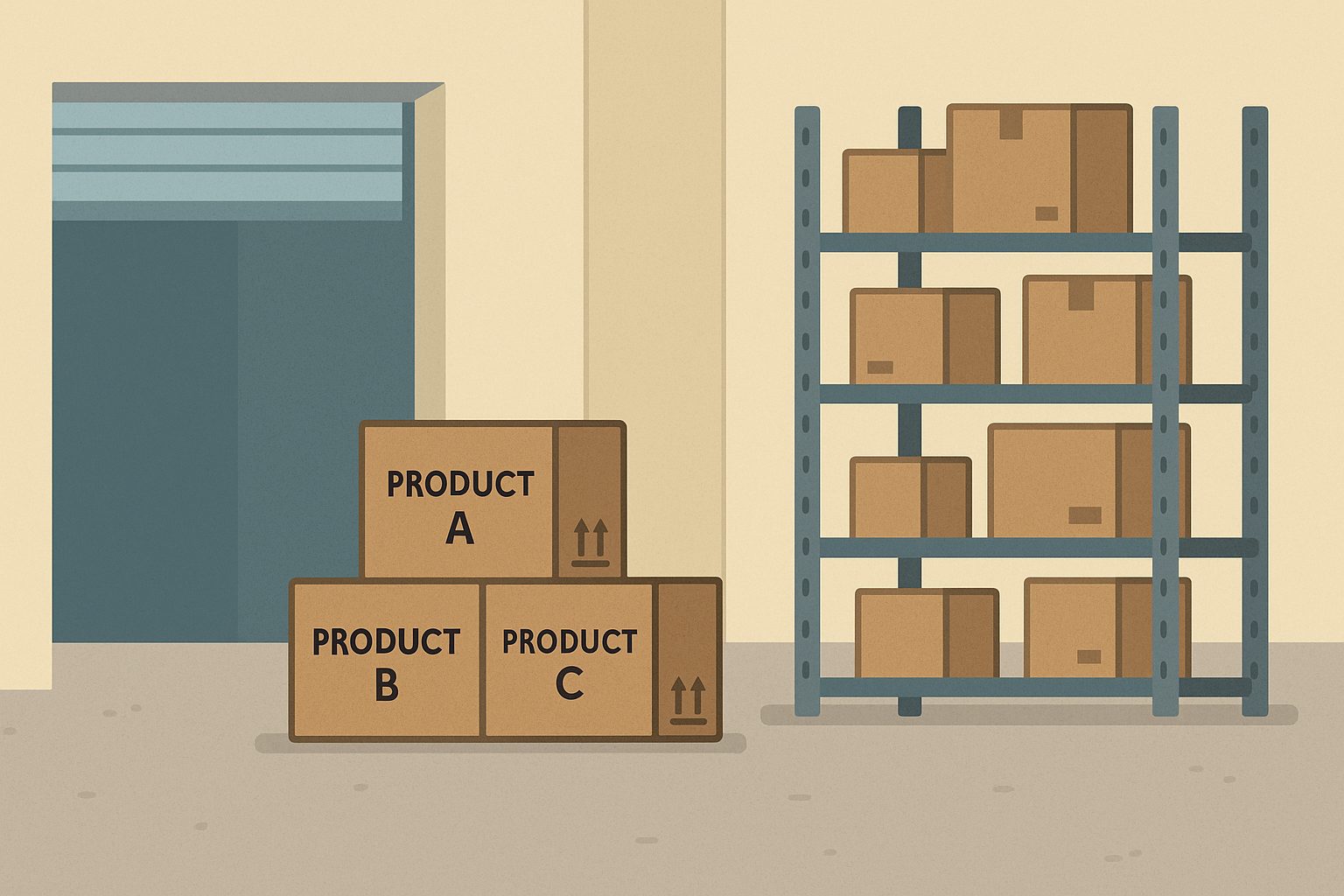Table of Contents
Most small businesses don’t sit on piles of stock—and frankly, they can’t afford to. Warehousing costs keep rising. Payments get delayed. Space is limited. In that reality, just-in-time inventory isn’t just a lean supply chain strategy. It’s survival.
JIT works by matching inventory levels closely to what’s actually needed, when it’s needed. No overstocking. No idle cartons gathering dust. You order based on real demand—day by day, batch by batch. For MSMEs, that means fewer headaches tied up in unsold goods or cash blocked in warehousing.
But here’s the catch: JIT only works when logistics move like clockwork. One late delivery, one missed dispatch window—and the whole setup collapses. For a lot of MSMEs, the problem isn’t understanding JIT. The problem is depending on logistics providers who don’t always show up when promised.
Take a small fabric wholesaler in Surat. They moved to JIT to reduce over-ordering, keeping only three days’ worth of stock. It worked great—until a courier delayed a delivery during monsoon season. Production at their client’s stitching unit came to a halt. That one missed handoff? It cost them a month-long order.
This is where many businesses misjudge the JIT model. It’s not just about ordering less. It’s about setting up a logistics rhythm that never stumbles. That rhythm depends on delivery predictability, vendor accountability, and often, choosing the right freight model—PTL, courier, or even an in-city runner. The tighter your inventory, the tighter your dispatch coordination needs to be.
So if you’re thinking of adopting JIT, start not with what’s in your warehouse—but with how your goods move in and out. That’s where the real story begins.
How JIT Impacts Your Logistics Strategy
Switching to just-in-time isn’t just a warehouse decision—it completely reshapes how your logistics need to work. When stock levels are low, you can’t afford delays. There’s no buffer. That means your delivery schedules, vendor coordination, and freight choices all come under a sharper lens.
For MSMEs shipping across states, even one missed truckload or a late courier can knock production off-track. Think about it—if your production team expects a component by 3 p.m., and it shows up at 6, you’ve lost a shift. Multiply that across a week, and suddenly, JIT feels riskier than holding excess stock.
This is why JIT forces businesses to tighten their transit time commitments. Many MSMEs shift from generic courier services to more structured PTL (Part Truckload) providers who offer fixed delivery windows. A Kolkata-based spare parts supplier, for example, moved from parcel shipping to a fixed-route PTL plan with a mid-size logistics player. Their delivery windows narrowed from ±2 days to ±4 hours. That gave their customers just enough confidence to reduce buffer stock.
Another area that JIT touches deeply? Reverse logistics. Say your goods get damaged in transit—what happens then? If you don’t have a fast, clear pickup-and-replace system, JIT breaks down fast. You’re left scrambling, losing both time and customer trust. So, your returns process has to run just as smoothly as your dispatches.
And it’s not just about speed. It’s also about consistency. JIT works only when suppliers and carriers stick to their promises—every single time. That’s why businesses moving toward JIT often rewrite their SLAs (Service Level Agreements), build in penalties for missed slots, and start demanding real-time tracking from their partners.
The bottom line? JIT isn’t fragile—but it is unforgiving. It makes your logistics stronger, faster, and smarter—or it exposes every weak link you didn’t know you had.
Choosing the Right Delivery Model for JIT Success
If you’re running lean on inventory, your delivery model can’t be one-size-fits-all. Every late truck, overcharged courier, or half-full shipment chips away at the promise of just-in-time inventory. That’s why MSMEs need to choose the right transport method—not based on cost alone, but on frequency, reliability, and shipment size.
Start with a basic question: How often do you dispatch? If it’s once or twice a week, a well-scheduled FTL (Full Truck Load) might work. But if your orders go out daily in smaller batches, PTL (Part Truck Load) or even courier services offer more flexibility.
Let’s take a small home décor brand based in Jaipur. They dispatch around 8–10 medium parcels daily to retailers across three states. Initially, they used surface couriers. But with fluctuating delivery times and high return rates, it wasn’t sustainable. They shifted to a regional PTL partner with a fixed daily pickup slot and dedicated tracking updates. Damaged goods dropped. Costs stabilized. And JIT? Much smoother.
Here’s where most MSMEs go wrong: They focus only on upfront transport cost. But with JIT, delay cost matters more—missed production hours, customer churn, idle labor. That hidden cost is what makes reliable logistics worth it.
Still, not every provider will match your rhythm. If your delivery frequency is irregular—say, three orders one day, none the next—some partners might push your consignments to the next available truck. That kills the whole point of JIT. Look for partners who run frequent line hauls or offer flexible booking slots, even if you’re not shipping high volumes.
Also consider geographic coverage. For local moves within city or district, a two-wheeler-based intra-city courier might be perfect. But for pan-India coverage, you’ll need a partner with cross-docking hubs, not just pin code reach.
The right delivery model isn’t about scale. It’s about rhythm. Match your shipment rhythm to your logistics partner’s operating pattern—and that’s when JIT starts to feel less risky and more rewarding.
Tech Tools That Help Implement Just-in-Time Inventory
When you’re working with tight stock levels, technology isn’t optional—it’s essential. Just-in-time inventory needs fast coordination, real-time visibility, and minimal lag between decision and dispatch. Thankfully, even without big ERP budgets, Indian MSMEs can now tap into tech that works at ground level.
Live Tracking to Reduce Uncertainty
Logistics becomes unpredictable the moment your shipment leaves the gate. Without visibility, you’re stuck waiting—and hoping. That doesn’t work in a JIT setup.
Live tracking tools solve this. Whether it’s a docket number from a courier or a PTL LR number, platforms like Delhivery, Shadowfax, and Shiprocket now offer real-time updates with hub scans and estimated arrival times. For MSMEs shipping daily or alternating days, this clarity helps prevent guesswork—and panic calls from buyers.
One dispatch manager from a Pune-based valve supplier put it well: “Earlier we’d buffer one extra day. Now, I just open the panel and track down to the route.”
Inventory Sync with Sales and Dispatch
If your inventory doesn’t sync with orders, you’re flying blind. You might think there’s enough stock for today’s dispatch—until your team realises that two units already went out yesterday.
To avoid this, many MSMEs use basic sync setups: Google Sheets with inventory formulas, Vyapar for integrated billing-stock sync, or Zoho Inventory for tighter control. Even Busy or Tally add-ons can help maintain real-time views. When dispatch and sales talk to each other, restocking becomes smarter—not just reactive.
This works well for small businesses dispatching 3–5 SKUs regularly, where even a slight mismatch could stall production or lead to order cancellations.
Reverse Logistics Made Transparent
JIT doesn’t just depend on fast dispatch—it also needs fast resolution when things go wrong. If a product gets damaged or returned, how quickly can you replace it? That’s where reverse logistics tools come in.
Companies like eKart and Bluedart offer reverse pickup modules through their dashboards. Some logistics aggregators even allow you to schedule a reverse pickup directly from your customer’s address—without a separate call.
For MSMEs, especially in home décor or electronics, where returns happen often, this can keep the JIT loop running without manual chaos.
Mobile Apps for Dispatch and Vendor Coordination
Most MSME teams don’t sit behind desks all day. Dispatch heads might be on the shop floor, at a supplier’s godown, or coordinating loading at 6 a.m. That’s why mobile-first tools make a huge difference.
Apps like ClickPost, Pickrr, or even WhatsApp integrations let your team scan parcels, confirm pickups, update delivery status, and notify buyers—all without needing a laptop.
This flexibility is critical when you’re managing 5–10 shipments a day across different regions. It’s not about scale—it’s about keeping your dispatch rhythm intact.
Demand Forecasting on a Budget
Forecasting doesn’t have to be complex to be useful. Even tracking last month’s movement in a spreadsheet—combined with upcoming orders—can give you a decent reorder point.
For JIT to work, you must know when to place the next order before running dry. Tools like Groww, Odoo Inventory, or even Excel templates with weighted averages can give you a view that’s good enough. You’re not predicting the future—you’re staying ahead by two or three days. That’s all JIT needs.
One MSME in Ahmedabad uses a simple rule: “If we sell 50 units of a SKU in 5 days, we trigger a reorder at 20.” No software. Just logic, speed, and clarity.
Operational Challenges MSMEs Face and How to Solve Them
Just-in-time inventory sounds clean on paper. But once you apply it to real-world logistics in India—rain delays, closed warehouses, missing LRs—it gets messy fast. MSMEs trying to implement JIT often run into a set of recurring issues. The good news? Most of them are solvable with a mix of planning, partner alignment, and on-ground clarity.
Delay-Driven Breakdowns in Production
This is the most common—and damaging—problem. Your production team is waiting for raw material. The truck’s late. There’s no buffer stock. Now the entire day’s work is gone.
To handle this, MSMEs need two things: firm transit SLAs and a fallback system. First, set clear delivery windows with penalties or credits. Second, identify a secondary local vendor who can supply a short-term replacement in emergencies—even if it’s costlier. You’re not replacing your main vendor. You’re buying time.
A Bengaluru-based electronics assembler uses this exact model. Their lead vendor sends components on a 48-hour cycle. If that fails, a nearby supplier fills a stopgap batch for 20% higher cost—just enough to keep the line running.
Damage in Transit — and No Time to React
When you’re working JIT, you don’t have extras lying around. One damaged box, one broken unit, and you’re scrambling.
This is why packaging isn’t just the vendor’s responsibility—it’s yours too. Guide your vendors on using bubble-wrap, reinforced cartons, or shock sensors if needed. Also, request photos of packed material before dispatch. Some MSMEs even mark “JIT – Fragile – Time Critical” on parcels. It helps at hubs.
And don’t ignore the returns loop. If your logistics partner doesn’t handle reverse pickups swiftly, you’ll lose more than the damaged goods—you’ll lose time, trust, and production flow.
Vendor Slippage and Misaligned Expectations
JIT only works when your vendors run like clockwork. If they dispatch late, forget invoices, or skip tracking updates—you’re in trouble. Most MSMEs struggle here because the vendor relationship isn’t always formalized.
A quick fix? Use shared tools. Even a Google Sheet updated daily, with committed vs. actual dispatch dates, can reveal gaps. Over time, this creates accountability. You’ll know which vendors stick to the plan and which don’t.
One furniture MSME in Jodhpur solved this by creating a simple three-column sheet shared over WhatsApp: Order Date, Promised Dispatch, Actual Dispatch. It turned passive vendors into responsive partners.
Mismatch Between Logistics Partner and Inventory Rhythm
If your freight partner works on a 3-day pickup cycle, but you need daily shipments to stay lean, JIT collapses. MSMEs often discover this mismatch too late—after committing to a fixed vendor.
What helps here is trial shipments and a review period before locking contracts. Track service levels for 2–3 weeks. Measure delay frequency, response to escalations, and delivery consistency. If it doesn’t align with your JIT rhythm, don’t move forward—no matter how cheap the quote is.
JIT isn’t about perfection. It’s about setting up a reliable rhythm, and having small backups when that rhythm stutters. Fix what you can control—packaging, coordination, follow-ups—and buffer what you can’t.
Conclusion
Running lean isn’t about cutting corners—it’s about staying sharp. For small businesses, especially the ones juggling production, dispatch, and follow-ups all in the same day, just-in-time inventory isn’t theory. It’s how you stay afloat without drowning in stock.
But JIT only holds up when your logistics does. Deliveries that land too early? Wasted space. Too late? Lost orders. You need freight partners who don’t just promise timelines—they hit them; vendors who send a heads-up before you chase them and finally, you need systems, yes—but also habits. Simple ones. Daily ones.
Don’t overcomplicate it. Start with what breaks the most. Is it late trucks? Wrong packaging? No visibility? Fix that first. Use what you have—sheets, phone calls, a simple Kanban board. Build consistency, not complexity.
Because in the end, JIT isn’t about moving faster. It’s about moving just right.
Need reliable logistics solutions for your business?
Tata nexarc helps businesses streamline their supply chain with trusted transporters, competitive pricing, and real-time tracking—ensuring timely and cost-effective delivery across India.
FAQs
What is the difference between JIT and lean inventory management?
Can JIT inventory work without a digital inventory management system?
Is JIT feasible for seasonal or irregular demand businesses?
How does GST impact JIT procurement cycles in India?
Can JIT apply to B2C e-commerce businesses or only B2B?
What’s the role of third-party warehouses in supporting JIT?
How can MSMEs negotiate better SLAs with logistics providers for JIT?
What is the risk of supply chain disruption in a JIT model?
How do international suppliers fit into JIT for Indian MSMEs?
Can JIT help with working capital management for small manufacturers?
Ananya Mittal blends a background in data science with a passion for writing, contributing to Tata Nexarc’s efforts in creating insightful, data-informed content for MSMEs. Her work focuses on exploring sector-specific challenges and opportunities across procurement, logistics, and business strategy. She is also involved in leveraging analytics to strengthen content performance and deliver actionable insights to India's growing B2B ecosystem.













This is a well-explained piece on how Just-in-Time (JIT) inventory can be a game-changer for MSMEs. Reducing storage costs and minimizing waste are crucial benefits for smaller businesses operating on tighter margins. I especially liked the emphasis on planning and supplier coordination — two factors that can make or break a successful JIT implementation. Thanks for shedding light on how MSMEs can adopt big-business strategies in a smart, scalable way!